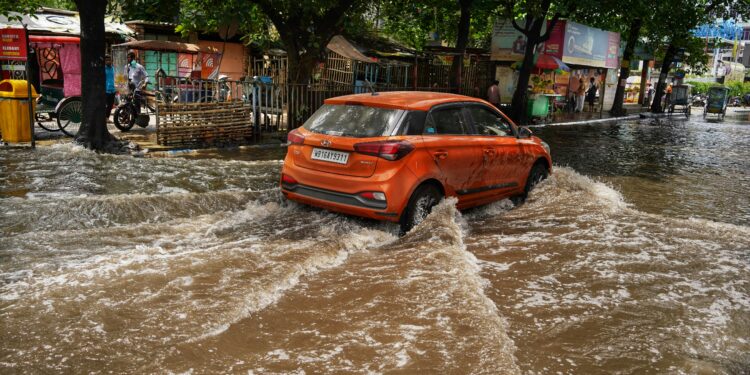Severe Rainfall Alert: 10 Essential Preparedness Steps

From flash floods that inundate urban areas in minutes to landslides that reshape landscapes, the impact of heavy downpours can be devastating, leading to property damage, displacement, and even loss of life. While we cannot control the weather, we can certainly control our readiness.
Proactive preparation is not just a recommendation; it’s an essential strategy for minimizing risks and ensuring the safety of ourselves, our families, and our communities.
This article serves as your practical guide, providing a comprehensive checklist of 10 essential steps to take when a severe rainfall alert is issued, empowering you to face the storm with confidence and resilience.
Understanding the Threat: What a Severe Rainfall Alert Signals
A severe rainfall alert is more than just a weather forecast; it’s a critical warning that significant and potentially dangerous precipitation is expected. These alerts are issued by meteorological agencies and disaster management authorities when specific criteria are met, such as a high intensity of rainfall over a short period, or prolonged heavy rain that could lead to widespread saturation and runoff.
It’s crucial to understand that these alerts signal a real and imminent threat of hazards like flash floods, which can develop rapidly in low-lying areas, urban centers, and near rivers, and landslides or mudslides, particularly in hilly or deforested regions.
Paying immediate attention to these alerts is paramount, as they provide the precious window of time needed to enact safety measures. While a “watch” indicates conditions are favorable for severe weather, a “warning” means the severe rainfall alert is already occurring or is imminent, demanding immediate action.
Before the Drops Fall: Your Pre-Rainfall Action Plan
The moments before a severe rainfall alert are critical for preparation. Taking these proactive steps can significantly reduce potential harm and damage.
- Stay Informed & Monitor: Your first line of defense is reliable information. Continuously monitor official weather forecasts from your national meteorological service (e.g., local weather channels, government weather websites). Tune into local news broadcasts and ensure your mobile phone is set up to receive emergency alerts. Consider downloading a reliable weather app that provides real-time updates and notifications for your area. Knowledge is power when facing unpredictable weather.
- Emergency Kit Assembly: A well-stocked emergency kit is your lifeline. This “go-bag” should be easily accessible and contain essentials for at least 72 hours. Include:
- Water: At least one gallon per person per day.
- Non-perishable food: Easy-to-prepare items.
- First aid kit: With bandages, antiseptic wipes, pain relievers, and any personal medications.
- Flashlight and extra batteries: For power outages.
- Power bank: Fully charged for mobile devices.
- Whistle: To signal for help.
- Multi-tool: For various needs.
- Copies of important documents: (IDs, insurance policies, medical records) stored in a waterproof bag.
- Home & Property Protection: Take immediate steps to protect your home from water damage.
- Clear Gutters and Drains: Ensure all gutters, downspouts, and storm drains around your property are free of leaves and debris to allow water to flow away efficiently.
- Secure Outdoor Items: Bring in or secure any outdoor furniture, trash cans, grills, or other items that could be swept away or become projectiles in strong winds or floodwaters.
- Move Valuables: If you live in a flood-prone area or expect significant water accumulation, move important documents, electronics, and cherished belongings to higher floors or elevated areas within your home.
- Consider Sandbags: If you have known entry points for water or anticipate significant flooding, strategically place sandbags to divert water away from your property.
- Vehicle Preparedness: Your vehicle can become a hazard in heavy rain.
- Check Tires, Brakes, and Wipers: Ensure your vehicle is in good working order. Proper tire tread is crucial for traction on wet roads.
- Avoid Driving Through Floodwaters: This is perhaps the most critical rule. “Turn around, don’t drown.” Even shallow water can hide hazards, sweep your vehicle away, or stall your engine, leaving you stranded. If you encounter flooded roads, find an alternative route.
Family & Communication: Ensuring Everyone is Safe
In any emergency, knowing your family is safe and how to reach them is paramount. A comprehensive family emergency plan is vital for severe rainfall events.
- Develop a Family Emergency Plan: Sit down with your household members to create a clear plan. This should include designated safe rooms in your home, primary and alternative meeting points outside your home (in case of immediate evacuation), and roles for each family member during an emergency. Practice this plan regularly so everyone knows what to do.
- Contact Information: Compile a physical list of essential contact numbers for all family members, friends, doctors, schools, and local emergency services. Do not rely solely on digital contacts, as power outages can render devices useless. Keep this list in your emergency kit and in a central, accessible location in your home.
- Charge Devices: Ensure all mobile phones, laptops, and any portable communication devices are fully charged well in advance of a severe rainfall alert. Portable power banks are invaluable for keeping devices powered when electricity is out.
- Pet Safety: Don’t forget your furry, feathered, or scaled family members. Include pets in your evacuation plans, ensuring you have carriers, food, water, and any necessary medications for them. Many shelters do not accept pets, so identify pet-friendly alternatives beforehand.
Evacuation Readiness: When to Leave and How
Sometimes, the safest action during a severe rainfall alert is to evacuate. Knowing when and how to do so can be life-saving.
- Know Your Routes: Identify primary and alternative evacuation routes from your home, workplace, and any other frequently visited locations. Familiarize yourself with higher ground and safe zones in your community. Local emergency management agencies often provide maps with designated evacuation routes.
- Designate Meeting Points: Establish specific, easily identifiable meeting points outside your immediate neighborhood and further afield, where family members can reunite if separated during an evacuation.
- Listen to Authorities: Always, without exception, follow official evacuation orders issued by local authorities. These orders are based on expert assessments of risk to life and property. Do not wait for conditions to worsen before complying.
- “Grab-and-Go” Bag: Ensure your pre-assembled emergency kit (your “go-bag”) is easily accessible and ready for quick departure. When an evacuation order comes, every second counts.
The 10 Essential Preparedness Steps at a Glance
To make your preparation quick and efficient, here’s a consolidated list of the 10 crucial steps to take when a severe rainfall alert is issued:
- Stay Informed & Monitor Official Alerts: Continuously check official weather forecasts and emergency broadcasts.
- Assemble a Comprehensive Emergency Kit: Prepare a “go-bag” with essentials for at least 72 hours.
- Protect Your Home & Property: Clear drains, secure outdoor items, and move valuables to higher ground.
- Prepare Your Vehicle: Check tires, brakes, and wipers, and never drive through floodwaters.
- Develop a Family Emergency Plan: Create and practice a plan for communication and meeting points.
- Compile Essential Contact Information: Keep a physical list of emergency contacts.
- Charge All Communication Devices: Ensure phones and power banks are fully charged.
- Include Pets in Your Evacuation Plan: Prepare carriers, food, and water for your animals.
- Know Your Evacuation Routes & Meeting Points: Identify safe paths and rally points.
- Always Listen to & Follow Authority Directives: Comply immediately with official evacuation orders.
Preparedness as a Pillar of Resilience
Facing a severe rainfall alert can be daunting, but as this guide has shown, effective preparation is the most powerful defense against its potential impacts.
By understanding the threat, implementing a robust pre-rainfall action plan, ensuring clear family communication, and maintaining evacuation readiness, you foster not only your immediate safety but also the long-term resilience of your household and community.
These essential steps are not one-time tasks but ongoing commitments to vigilance and proactive safety. Embrace preparedness as a fundamental pillar of your well-being, empowering you to navigate any deluge with confidence and emerge stronger on the other side.
Next Read: Severe Heatwave Alert: 10 Mistakes to Avoid in Extreme Temperatures








